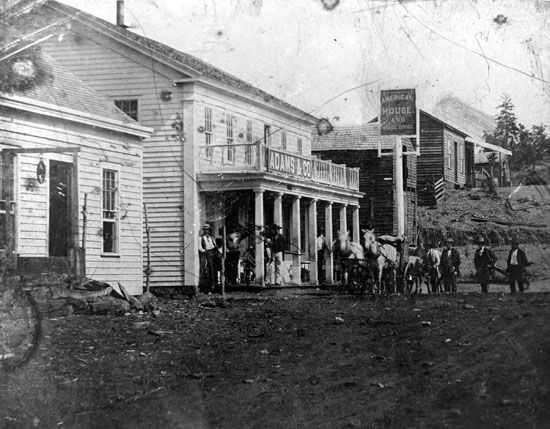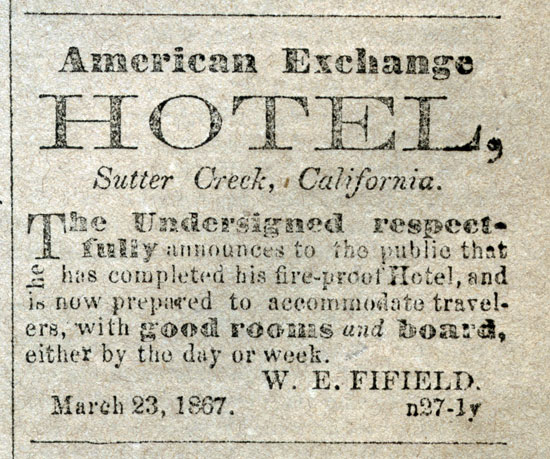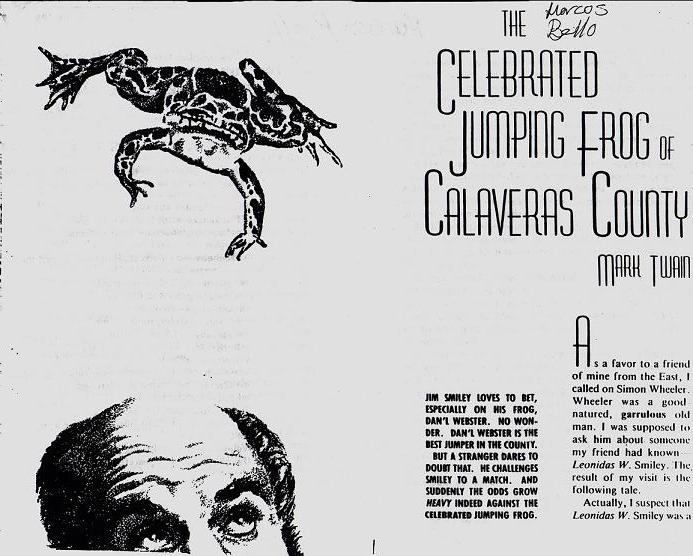California - Summer 2007
The Gold Rush Trail - Day 2: California Highway 49
Sutter Creek
Sutter Creek, known as the "Jewel of the Mother Lode," was named after John Sutter, who sent a party to the area in 1846 in search of timber. Sutter logged this area for awhile before heading back to his fort. His discovery of gold at nearby Coloma in January of the year 1848 triggered the California Gold Rush.

Sutter Creek, Main Street 1853-54
Photo Source: http://www.american-exchange-hotel.com/5675_adamsandco.html

Sutter Creek, Main Street

American Exchange Hotel

Photo Source: http://www.american-exchange-hotel.com/1867AmadorDispatchAd_550.html
Sutter Gold Mine Tour
We took an hour-long walking excursion into the bowels of a modern hard-rock gold mine. The tour started with a ride on a mining shuttle to the mine, where we "tagged in" and went through the safety training room, as did the miners. Wearing our hard hats, we proceeded deep into the mine, learning about geology and the history while marveling at the gems and gold embedded in the quartz of the Comet Vein (we even learned to distinguish real gold from "fool's gold").

Placerville, California (Old Hangtown)
The history of Placerville began with the "rush for gold" to California in the 1840’s. The highly publicized discovery of gold in the tailrace section at Sutter’s Mill in Coloma (only 10 miles from Placerville) in 1848 resulted in the migration of thousands of fortune-seekers to Northern California in the mid 1800’s. The town of Placerville was named after the placer deposits found in the river bed between Spanish Ravine and the town plaza. During the gold rush, Placerville became an important supply center for the surrounding mining camps.
Hangman's Tree Tavern
The Hangman's Tree's significance stems from its notorious heritage originating from the 1849 Gold Rush Days. The tree, which grew in a place called Hay Yard, was a sturdy structure used to bring swift justice in the form of death by hanging to those who stole, killed, lied, cheated and generally made the majority population upset. Placerville was originally named Dry Diggins but due to the number of hangings, the name Hangtown was adopted for the justice meted out by "Judge Lynch." Immediate punishment could include whipping, banishment or worst yet, hanging.
In a brief 20 to 30 minutes a man's life could end with the sentence of death by hanging. The famous hanging tree once stood in Elstner’s Hay Yard next to the Jackass Inn but today, the stump is in the cellar of The Hangman’s Tree tavern on Historic Main Street, Placerville.
The Bell Tower, Main Street
The Bell Tower, once used as a warning bell for fire, is located on main street which is a landmark in the area. The history of the Bell Tower began back in l856. Three fires that year in April, July and August, claimed most of Placerville's business section. The need for an alarm system to call the volunteer fire department was obvious, and a bell was ordered from England. Cast in 1860, the bell arrived in Placerville in 1865.

Hello From Placerville
I promised these dudes that I'd put their picture on my Web site.
Angels Camp, California - Home of the Jumping Frog

Replica of Mark Twain's Cabin
Here on Jackass Hill, young Mark Twain, while a guest of Gillis Bothers, 1864-65, gathered material for "The Celebrated Jumping Frog of Calaveras County," which first brought him fame.The cabin burned but was rebuilt in 1922 with the original chimney and fireplace.
"The Celebrated Jumping Frog of Calaveras County" is an 1865 short story by Mark Twain. It was also published as "The Notorious Jumping Frog of Calaveras County" and "Jim Smiley and His Jumping Frog." In it, the narrator retells a story he heard from a bartender at the Angels Hotel in Angels Camp, California, about the hopeless gambler Jim Smiley told by Simon Wheeler, a fat and bald-headed man. Twain describes him: "If he even seen a straddle bug start to go anywheres, he would bet you how long it would take him to get to--to wherever he going to, and if you took him up, he would foller that straddle bug to Mexico but what he would find out where he was bound for and how long he was on the road."

The Front page of "The Celebrated Jumping Frog
of Calaveras County"
Photo Source: http://en.wikipedia.org/wiki/Image:Jumping_frog1.jpg